

Pictures Segregation. Jim Crow Laws. Jim Crow Laws were statutes and ordinances established between 1874 and 1975 to separate the white and black races in the American South.
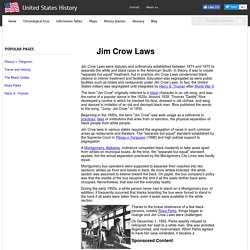
In theory, it was to create "separate but equal" treatment, but in practice Jim Crow Laws condemned black citizens to inferior treatment and facilities. Education was segregated as were public facilities such as hotels and restaurants under Jim Crow Laws. In fact, the United States military was segregated until integrated by Harry S. Truman after World War II. Academy of Achievement. How Rosa Parks Fought for Civil Rights. Sitting Down On Thursday evening December 1, 1955, after a long day of work as a seamstress for a Montgomery, Alabama, department store, Rosa Parks boards a city bus to go home.

Tired as she is, Mrs. Parks walks past the first few — mostly empty — rows of seats marked "Whites Only. " It's against the law for an African American like her to sit in these seats. Ruby Bridges. Martin Luther King Jr. Day: Facts, Timeline, History, Activities, Bio. Jim Crow Laws. History >> Civil Rights for KidsWhat were the Jim Crow laws?
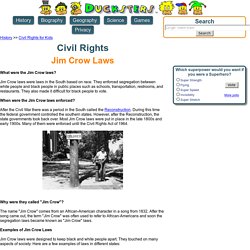
Jim Crow laws were laws in the South based on race. They enforced segregation between white people and black people in public places such as schools, transportation, restrooms, and restaurants. They also made it difficult for black people to vote. When were the Jim Crow laws enforced? Biography for Kids: Ruby Bridges. History >> Biography >> Civil Rights for Kids Occupation: Civil Rights Activist Born: September 8, 1954 in Tylertown, Mississippi Best known for: First African-American student to attend an all-white elementary school in the SouthBiography: Where did Ruby Bridges grow up?

Ruby Bridges grew up on a small farm in Tylertown, Mississippi. Her parents were sharecroppers, meaning they farmed the land, but didn't own it. When Ruby was four years old, her family moved to New Orleans. In New Orleans, Ruby lived in a small apartment where she shared a bedroom with her sister and two younger brothers. African-American Civil Rights Movement. History >> Civil Rights for Kids March on Washington Aug 28, 1963from the United States Information Agency The African-American Civil Rights Movement was an ongoing fight for racial equality that took place for over 100 years after the Civil War.
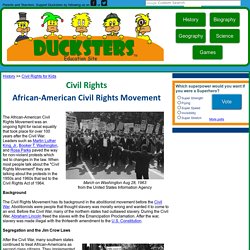
Leaders such as Martin Luther King, Jr., Booker T. March on Washington. Segregation. Before 1954.

Tommie Smith on 1968 Olympic protest with John Carlos, athlete activism - Sports Illustrated. There wasn’t a specific plan in place on that day in Mexico City in October 1968, when 24-year-old Tommie Smith won the Olympic gold medal in the men’s 200 meters and approached the podium alongside third-place finisher and fellow American John Carlos.

But both men knew they would protest against racial injustice in some form. What they didn’t know is that their actions would spark a legacy of athlete activism. Martin Luther King I Have a Dream Speech - American Rhetoric. Martin Luther King, Jr.
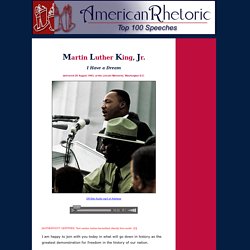
I Have a Dream delivered 28 August 1963, at the Lincoln Memorial, Washington D.C. Video Purchase Off-Site audio mp3 of Address [AUTHENTICITY CERTIFIED: Text version below transcribed directly from audio. (2)] ‘I Have a Dream' Speech - MLK, Dates & Summary. The “I Have a Dream” speech, delivered by Martin Luther King, Jr. before a crowd of some 250,000 people at the 1963 March on Washington, remains one of the most famous speeches in history.

Weaving in references to the country’s Founding Fathers and the Bible, King used universal themes to depict the struggles of African Americans before closing with an improvised riff on his dreams of equality. The eloquent speech was immediately recognized as a highlight of the successful protest, and has endured as one of the signature moments of the civil rights movement. Civil Rights Momentum Martin Luther King, Jr., a young Baptist minister, rose to prominence in the 1950s as a spiritual leader of the burgeoning civil rights movement and president of the Southern Christian Leadership Conference (SLCC).
The Life of Rosa Parks. Rosa Parks and Martin Luther King. Civil Rights Movement: Timeline, Key Events & Leaders. The civil rights movement was a struggle for social justice that took place mainly during the 1950s and 1960s for blacks to gain equal rights under the law in the United States.
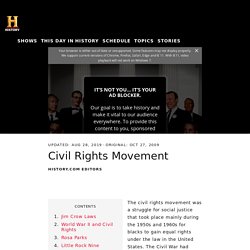
The Civil War had officially abolished slavery, but it didn’t end discrimination against blacks—they continued to endure the devastating effects of racism, especially in the South. By the mid-20th century, African Americans had had more than enough of prejudice and violence against them. They, along with many whites, mobilized and began an unprecedented fight for equality that spanned two decades. Jim Crow Laws During Reconstruction, blacks took on leadership roles like never before. School Integration Webpicks – Speakeasy News. Brown v. the Board of Education in 1954 is remembered in the U.S. as a landmark moment in the fight for civil rights.
The segregated school that seven-year-old Linda Brown attended while the case for desegregation made its way through the courts is now a National Park Service Historic Site. These videos and websites are useful for covering this topic in class. This video is from the National Park Service Brown vs Board of Education Historic Site in Topeka, Kansas. It's available to watch online, or download. It's subtitled in English, and there is a transcript available. It alternates testimony from the late Mrs Zelma Henderson, one of the 13 parents associated in the Brown v Board of Education case with scripted commentary delivered by two teenagers, one black, one white. The segment from 7:00 to 9:35 is very usable because it gives very concrete examples of how schoolchildren faced discrimination. Separate is NOT Equal This is a well produced video from the State Bar of Georgia. Mexico Olympics Black Power Protest Video – Speakeasy News. Green book cover 1959 edition.
Topic segregation promo getty 515579376. Sans titre. The Green Book, in full The Negro Motorist Green Book, The Negro Travelers’ Green Book, or The Travelers’ Green Book, travel guide published (1936–67) during the segregation era in the United States that identified businesses that would accept African American customers. Compiled by Victor Hugo Green (1892–1960), a Black postman who lived in the Harlem section of New York City, the Green Book listed a variety of businesses—from restaurants and hotels to beauty salons and drugstores—that were necessary to make travel comfortable and safe for African Americans in the period before passage of Civil Rights Act of 1964. Automobile travel exploded in the United States during the mid-20th century as more and more Americans were able to afford cars and had disposable income and leisure time (including paid vacations) that allowed them to explore the country.
Get exclusive access to content from our 1768 First Edition with your subscription. Subscribe today. Sans titre. Segregation in the United States. Segregation is the practice of requiring separate housing, education and other services for people of color. Segregation was made law several times in 18th and 19th-century America as some believed that Black and white people were incapable of coexisting.
Underground railroad. Black History: Interracial Marriage. A Brief History - Interracial marriage. Segregation in the USA. The real story of the Green Book.